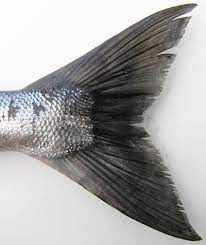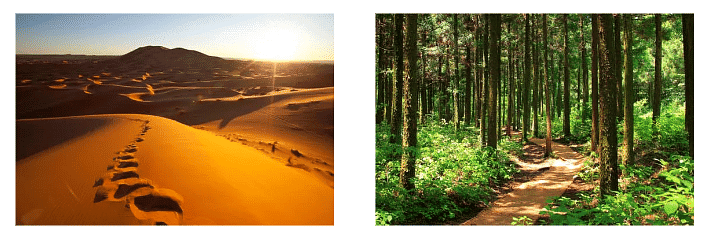Class 6 Science Chapter 6 Question Answers - The Living Organisms - Characteristics and Habitats
Q1: Different organisms have different habitats.(TRUE/FALSE)
Ans: True
Various species have adapted to specific habitats such as forests, deserts, oceans, grasslands, and more, based on their evolutionary characteristics and ecological requirements.
Q2: What are the functions of the fins and tails of fish?
Ans: To change direction while swimming and keep body balance in the water.

Q3: Water of sea is __________.
Ans: Saline
The water of the sea is saline, meaning it contains dissolved salts, primarily sodium chloride, making it different from freshwater found in rivers and lakes.
Q4: What is the function of gills in the body of fish?
Ans: Gills help them to use oxygen dissolved in water
Q5: Give two examples of different habitats of animals.
Ans: Camel lives in the desert and fish lives in water.
Q6: Why is the polar bear's habitat in the Arctic region?
Ans: The polar bear's habitat is in the Arctic region because it is adapted to the cold climate and relies on sea ice for hunting seals, which are a crucial part of its diet.
Q7: The plants and animals that live on land are said to live in __________habitat.
Ans: Terrestrial
It refers to the habitat or environment associated with land, as opposed to aquatic (water) habitats. Terrestrial habitats include various ecosystems such as forests, grasslands, deserts, and tundra, where plants and animals have adapted to life on land.
Q8: Habitat means a dwelling place. (TRUE/FALSE)
Ans: True
Habitat refers to a dwelling place or the natural environment where a particular species or community of organisms lives. It encompasses the physical surroundings, including the biotic (living) and abiotic (non-living) factors, that support and sustain life for those organisms.
Q9: Give two examples of terrestrial habitat.
Ans: Deserts and forests
 Desert and forest
Desert and forest
Q10: Habitat of plant and animal that lives in water is called ________ habitat.
Ans: Aquatic
Aquatic habitat refers to the habitat or environment associated with water. This includes various water bodies such as oceans, seas, rivers, lakes, ponds, and wetlands.
Q11: Non-living things such as soil, water, and air are ________components of a habitat.
Ans: Abiotic
Abiotic components of a habitat are the non-living factors that influence the living organisms within an ecosystem. These factors shape the physical and chemical characteristics of the environment.
Q12: What are the biotic components of habitat?
Ans: The living things such as plants and animals in a habitat are called its biotic components.
Q13: When is seed (e.g. moong seed) said to be germinated?
Ans: The seed is said to be germinated when it turns into a sprout.
Q14: Give two examples of each of the biotic and abiotic components of the environment.
Ans: Biotic components are plants and animals. Abiotic components are soil and water.
Q15: What are the abiotic components essential for the growth of a plant?
Ans: Water, sunlight, and air are essential for plant soil growth.
Q16: Adaptation takes place in thousands of years.(TRUE/FALSE)
Ans: True
Q17: What do animals like snakes, rats do to stay away from intense heat in deserts?
Ans: These animals come out only during night when it is cooler.
Many animals, including snakes and rats, adopt nocturnal behavior in deserts to avoid intense heat. They are often more active during the cooler nighttime temperatures, minimizing their exposure to the scorching heat of the desert during the day. This behavioral adaptation helps them conserve energy and cope with the challenging environmental conditions of deserts.

Q18: What types of leaves are there in desert plants?
Ans: In desert plants, leaves are either absent or very small or are spine-shaped to reduce water loss.
Q19: Adaptation to the environment is essential for the survival of an organism.(TRUE/FALSE)
Ans: True
Adaptation to the environment is essential for an organism's survival, involving traits and behaviors that enhance its ability to thrive in specific conditions.
Q20: Give one example of a desert plant.
Ans: Cactus
Q21: Photosynthesis in desert plants is usually carried out by __________.
Ans: Stem
In some desert-adapted plants, the stems, rather than leaves, may take on the role of photosynthesis to minimize water loss through transpiration. This adaptation helps them conserve water in arid environments.
Q22: What type of roots do desert plants have?
Ans: Desert plants have roots that go very deep into the soil to absorb water.
Q23: Give two examples of animals living in cold regions.
Ans: Yaks and snow leopard.
Q24: Stem of desert plants is covered with ________ which helps to retain water.
Ans: Waxy layer
The stem of desert plants is often covered with a waxy layer or cuticle, which helps to reduce water loss through transpiration and aids in retaining water in arid environments. This adaptation is crucial for the plant's survival in dry and hot conditions.
Q25: Mountain goats have strong hooves for running up the rocky slopes of the mountain.(TRUE/FALSE)
Ans: True
Mountain goats indeed have strong hooves adapted for running up the rocky slopes of mountains.
Q26: The animals eaten by predators are called __________.
Ans: Prey
 Prey- Deer & predator-Lion
Prey- Deer & predator-Lion
Q27: Name one characteristic of an aquatic habitat.
Ans: The presence of water is a characteristic of an aquatic habitat. Oceans, rivers, and ponds are examples.
Q28: The speed of deer helps it to run away from predators.(TRUE/FALSE)
Ans: True
The speed of deer is an adaptation that helps them escape from predators. Deer are known for their agility and speed, allowing them to quickly flee from potential threats, such as predators like wolves or big cats. This ability to run swiftly is a crucial survival strategy in the wild.
Q29: A whale can stay in water for a long time without breathing.(TRUE/FALSE)
Ans: True.
Q30: Lion hunts the deer therefore it is known as ___________.
Ans: Predator
Q31: Name two sea animals that do not have gills.
Ans: Dolphin and whale.
These marine mammals are mammals, not fish, and they breathe air at the surface through blowholes.
Q32: The long ear of deer has no role in adaptation.(TRUE/FALSE)
Ans: False.
The long ears of a deer play a role in adaptation. Deer have keen senses, including excellent hearing, which is crucial for detecting predators and potential threats. The large, mobile ears help them pick up sounds from a distance, enhancing their ability to sense danger and respond appropriately. This adaptation contributes to their survival in the wild.
Q33: ___________allows dolphins and whales to breathe in air when they swim near the surface of water.
Ans: Blowholes
Blowholes are the openings on the tops of the heads of dolphins and whales that allow them to breathe air when they surface. They are a crucial adaptation for these marine mammals, enabling them to quickly inhale and exhale while swimming in and out of the water.
Q34: Do all living things need food?
Ans: Yes
All living things require some form of sustenance or nourishment to fulfill their nutritional needs and sustain life processes. The specific type of food varies among different organisms, ranging from sunlight and nutrients for plants to organic matter for animals.
Q35: All living things show growth.(TRUE/FALSE)
Ans: True
All living things exhibit some form of growth, whether it's an increase in size, the development of new structures, or an increase in complexity. Growth is one of the characteristics that distinguish living organisms from non-living entities.
Q36: Food gives living organisms ___________ needed for growth.
Ans: Energy
Food provides living organisms with the energy needed for various life processes, including growth, maintenance, and reproduction.
 Breathing
Breathing
Q37: Breathing is a part of __________.
Ans: Respiration
Breathing is a part of the process of respiration. Respiration involves the exchange of gases, typically oxygen and carbon dioxide, and it includes breathing (the mechanical process of inhaling and exhaling) as well as cellular respiration (the metabolic process occurring within cells to produce energy).
Q38: Plants make their own food by the process of ________.
Ans: Photosynthesis
Q39: We breathe in ________of air and breathe out ___________.
Ans: Oxygen and Carbon dioxide
Q40: Earthworms breathe through ___________.
Ans: Skin
Earthworms breathe through their skin in a process called cutaneous respiration. Their skin is thin and moist, allowing for the exchange of gases, primarily oxygen and carbon dioxide, with the surrounding environment.
Q41: Amount of oxygen released in photosynthesis by plants is _______than oxygen they use in respiration.(MORE/LESS)
Ans: More
The amount of oxygen released in photosynthesis by plants is more than the oxygen they use in respiration. During photosynthesis, plants produce oxygen as a byproduct, and this oxygen is often released into the atmosphere. In contrast, during respiration, plants consume oxygen to generate energy, but the net result is a release of oxygen into the environment.
FAQs on Class 6 Science Chapter 6 Question Answers - The Living Organisms - Characteristics and Habitats
| 1. What are the characteristics of living organisms? |  |
| 2. What are habitats and why are they important for living organisms? |  |
| 3. How do living organisms adapt to their habitats? |  |
| 4. What are the different types of habitats? |  |
| 5. How do living organisms depend on their habitats? |  |

















